What a wonderful time of the year. Everyone is coming in and scooping up the fall veggies to plant in their gardens, and we are looking forward to the cooler days to come. Fall is the time for planting all of your cold-hardy species. While we enjoy this reprieve from the hot summer days, it doesn’t last long, and before we know it, we are scrambling to protect our plants from the elements. Colder weather comes along and we sometimes get sad thinking of barren trees, and the woody stems and branches that are left behind when our deciduous plants check out for the winter. But it doesn’t have to be a brown, drab, and dull winter. By planting your cold-hardy, evergreen plants now, you can continue with color through the winter, and all year round. We’ll be discussing some choices for evergreen shrubs, but the term evergreen is not limited to that category. You can find evergreen trees, groundcovers, and perennials as well.
 (This sure looks fun, but you don’t have to lose all your leaves this fall!)
(This sure looks fun, but you don’t have to lose all your leaves this fall!)
It’s a great time here at Rainbow Gardens for fall planting, because we have a ton of stuff on sale. Check out some of our suggestions below, and then take a peek at our Weekly Ad page on the website to see the great discounts we have in store for you.
If you’re looking for a way to add accents and beautify your landscape year round, how about planting some evergreen shrubbery. Shrubs come in a wide variety of shapes and sizes, so you are sure to find some that fit exactly what you need. You can find tall shrubs that you can plant along a fence line to give you privacy from peeping neighbors, or maybe you want some smaller sizes to adorn the front of your home. They can be used as a focal point, or back drop, or you can even use some of the dwarf or low growing shrubs in front borders. So, as you can see, the list is practically never-ending. Choosing an evergreen shrub gives you all of these options with the bonus of foliage and color year round.
Here are a few of our favorite choices along with some of their characteristics:
Boxwood (Japanese):
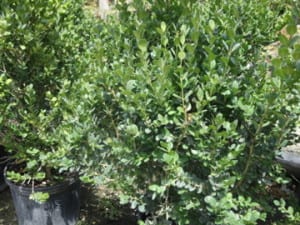 Boxwoods are definitely one of the shrubs at the top of our popularity list. They grow in a range of 1-4 feet tall, with a width spread of 1-3 feet wide. You can choose to place them in sun or part sun. A very versatile, deer-resistant shrub that you can use for borders, formal hedges, and even in containers. Customers love this species because you can shear them into precise geometric shapes. (Think Edward Scissorhands!) They can be rounded into perfect spheres, slanted slopes, or a prim and proper straight line. Have fun with these and form them to your personality. Dinosaur topiary anyone?
Boxwoods are definitely one of the shrubs at the top of our popularity list. They grow in a range of 1-4 feet tall, with a width spread of 1-3 feet wide. You can choose to place them in sun or part sun. A very versatile, deer-resistant shrub that you can use for borders, formal hedges, and even in containers. Customers love this species because you can shear them into precise geometric shapes. (Think Edward Scissorhands!) They can be rounded into perfect spheres, slanted slopes, or a prim and proper straight line. Have fun with these and form them to your personality. Dinosaur topiary anyone?
Viburnum (Sandankwa or Glossy):
 Viburnum are another of our favorite evergreen hedges, or privacy screen shrubs. They grow to heights of about 4-8 feet with a width of 3-4 feet. These shrubs produce little white flowers in early spring, but they are not very showy. The display the viburnum gives you are large, oval, glossy leaves. The draw to this shrub is not only it’s versatility with how you can prune it (hedge, or screen), but also how adaptable it is. We like plants that don’t give us grief, and this one can grow about anywhere. Planted in full or part sun, it will give you a nice landscape appearance without too much work, and it is also on the deer-resistant list.
Viburnum are another of our favorite evergreen hedges, or privacy screen shrubs. They grow to heights of about 4-8 feet with a width of 3-4 feet. These shrubs produce little white flowers in early spring, but they are not very showy. The display the viburnum gives you are large, oval, glossy leaves. The draw to this shrub is not only it’s versatility with how you can prune it (hedge, or screen), but also how adaptable it is. We like plants that don’t give us grief, and this one can grow about anywhere. Planted in full or part sun, it will give you a nice landscape appearance without too much work, and it is also on the deer-resistant list.
Primrose Jasmine:
 If you want an evergreen that looks a little different from your run of the mill shrubbery, come check out Primrose Jasmine. Growing 5-6 feet tall (or taller when supported) and spreading to a width of 3-6 feet, Primrose Jasmine can be a very showy specimen. The long, cascading branches are covered in small, vibrant green leaves. In early spring, these arching branches get bombarded with small, lemon-yellow flowers. Once this shrub has been established it can withstand long periods of drought. Prune by removing old dead branches deep inside the plant. If you shear them across the bottom you will lose some of their natural, cascading effect and end up with the “fry guys” from the McDonald’s commercials in the 70’s. Green in winter, drought-tolerant in summer, and deer-resistant? Sign us up!
If you want an evergreen that looks a little different from your run of the mill shrubbery, come check out Primrose Jasmine. Growing 5-6 feet tall (or taller when supported) and spreading to a width of 3-6 feet, Primrose Jasmine can be a very showy specimen. The long, cascading branches are covered in small, vibrant green leaves. In early spring, these arching branches get bombarded with small, lemon-yellow flowers. Once this shrub has been established it can withstand long periods of drought. Prune by removing old dead branches deep inside the plant. If you shear them across the bottom you will lose some of their natural, cascading effect and end up with the “fry guys” from the McDonald’s commercials in the 70’s. Green in winter, drought-tolerant in summer, and deer-resistant? Sign us up!
Fringe Flower (Purple Pixie)
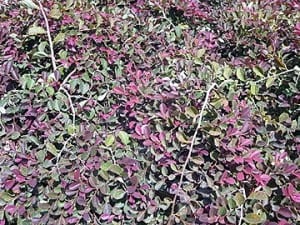 Now, just because we are talking about evergreen shrubs, doesn’t mean that we can’t have some other colors mixed in there as well. In fact, evergreen doesn’t mean that the plant itself is necessarily green, it just means that the plant keeps it’s leaves year round. So, that being said, we’d like to introduce you to the Fringe Flower shrub. This beautiful shrub is a dwarf version of some of the other fringe flowers, hence the name “Purple Pixie”. It grows 1-2 feet high and 3-4 feet wide. With it’s low growth habit, many choose to use this shrub as a type of groundcover; but it can also be a nice accent shrub in the foreground of your landscape, or a weeping specimen in a hanging basket. The vibrant purple foliage gets covered in showy pink flowers throughout the spring. Plant this one in full sun to get the most out of it’s delicious purple color.
Now, just because we are talking about evergreen shrubs, doesn’t mean that we can’t have some other colors mixed in there as well. In fact, evergreen doesn’t mean that the plant itself is necessarily green, it just means that the plant keeps it’s leaves year round. So, that being said, we’d like to introduce you to the Fringe Flower shrub. This beautiful shrub is a dwarf version of some of the other fringe flowers, hence the name “Purple Pixie”. It grows 1-2 feet high and 3-4 feet wide. With it’s low growth habit, many choose to use this shrub as a type of groundcover; but it can also be a nice accent shrub in the foreground of your landscape, or a weeping specimen in a hanging basket. The vibrant purple foliage gets covered in showy pink flowers throughout the spring. Plant this one in full sun to get the most out of it’s delicious purple color.
Acuba (Gold Dust)
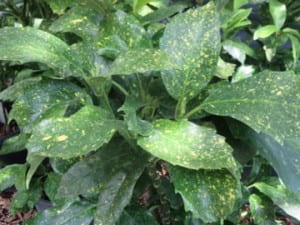 Now here is one for the shade that the deer leave alone. The yellow-speckled, glossy leaves of the Gold Dust Acuba are an excellent source for foliage color in heavily shaded areas. The speckled leaves almost look like a Jackson Pollock painting (if he was only using one color). The Acuba grows to about 4-8 feet tall, and 3-5 feet wide. It makes a wonderful landscape specimen, courtyard plant, or container plant. In the winter, the Acuba produces red berries that could possibly be used in your holiday decor. What a bonus. Provide it with good drainage, and if you notice the leaves turning black, it is getting too much sun.
Now here is one for the shade that the deer leave alone. The yellow-speckled, glossy leaves of the Gold Dust Acuba are an excellent source for foliage color in heavily shaded areas. The speckled leaves almost look like a Jackson Pollock painting (if he was only using one color). The Acuba grows to about 4-8 feet tall, and 3-5 feet wide. It makes a wonderful landscape specimen, courtyard plant, or container plant. In the winter, the Acuba produces red berries that could possibly be used in your holiday decor. What a bonus. Provide it with good drainage, and if you notice the leaves turning black, it is getting too much sun.
Texas Sage (Green Cloud)
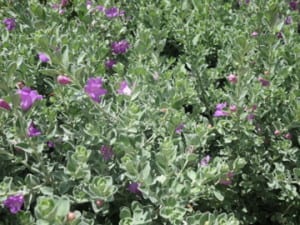 If you’ve lived in Texas for any period of time, you are sure to have noticed these native shrubs. Silvery-leaves with an abundance of purple flowers cover this low-maintenance evergreen. The flowers are produced spring through fall, with profuse blooming a few weeks after heavy rains. The Green Cloud Texas Sage is a more dense and vigorous growing version of the gray-leafed one. It grows 4-6 feet high and about 4 feet wide. If you need a shrub for a rock garden, or somewhere in your landscape that gets blasted with sun, this is the one for you. Once it is established, it really doesn’t need much care. Oh, and did we mention that it is also deer resistant?
If you’ve lived in Texas for any period of time, you are sure to have noticed these native shrubs. Silvery-leaves with an abundance of purple flowers cover this low-maintenance evergreen. The flowers are produced spring through fall, with profuse blooming a few weeks after heavy rains. The Green Cloud Texas Sage is a more dense and vigorous growing version of the gray-leafed one. It grows 4-6 feet high and about 4 feet wide. If you need a shrub for a rock garden, or somewhere in your landscape that gets blasted with sun, this is the one for you. Once it is established, it really doesn’t need much care. Oh, and did we mention that it is also deer resistant?
Xylosma (Shiny Japanese)
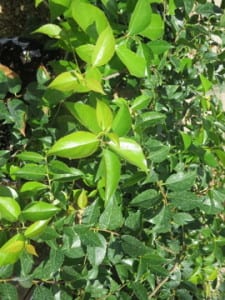 The Xylosma is a great alternative to Red Tip Photinias for your privacy hedge needs. This native xeriscape shrub does great in our limestone soils here in Central Texas. It has an upright growth habit that reaches from 6-22 feet, and a width of 4-5 feet. Other uses besides a privacy screen are as a foundation hedge or an outright specimen statement in your sunny landscape. The evergreen Xylosma produces small white flowers in the spring. It is tolerant of drought, but does best with supplemental watering during long extended dry periods.
The Xylosma is a great alternative to Red Tip Photinias for your privacy hedge needs. This native xeriscape shrub does great in our limestone soils here in Central Texas. It has an upright growth habit that reaches from 6-22 feet, and a width of 4-5 feet. Other uses besides a privacy screen are as a foundation hedge or an outright specimen statement in your sunny landscape. The evergreen Xylosma produces small white flowers in the spring. It is tolerant of drought, but does best with supplemental watering during long extended dry periods.
We have just touched on some of the choices you have for keeping your color year round. Many of these species we talked about come in different varieties as well. You can find dwarf version of the Boxwood, burgundy shades of the Fringe Flower, wipe off the gold dust speckles and go for the green Acuba. The possibilities are endless. So come on in and see us, ask us about more information on these and other evergreen shrubs we have available, and we’ll be back next week with choices for evergreen groundcovers.
This week’s Happy Gardener
Lisa Mulroy

Good morning I just planted a Japenese Xylosma. I am writing because it was in tree form and I am wondering if this particular tree attracts birds.
Hi Melanie,
Yes, the xylosma will create black berries that are attractive to birds and tiny, inconspicuous flowers will invite bees in to retrieve nectar. Make sure you give ample water for new plantings. The recent and predicted rains will help you out with this.